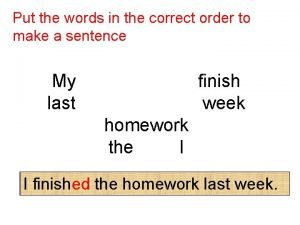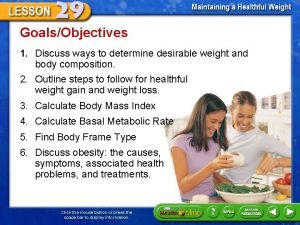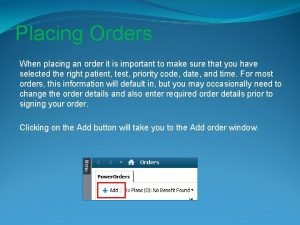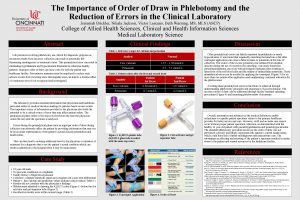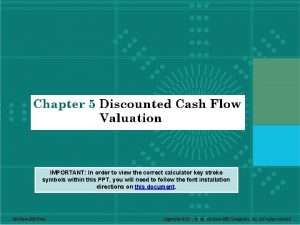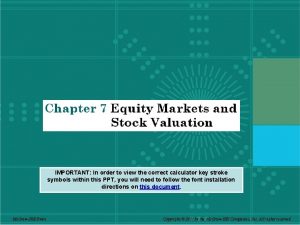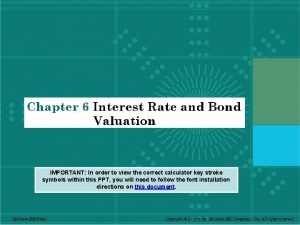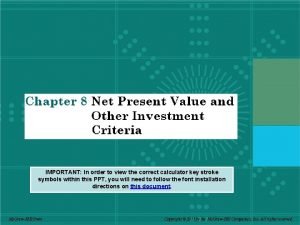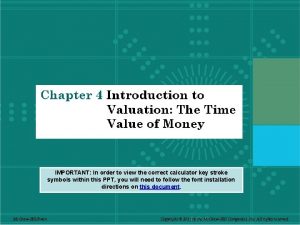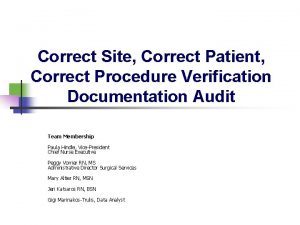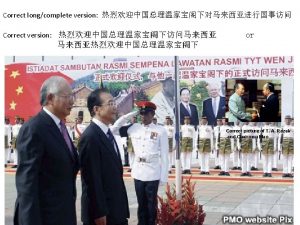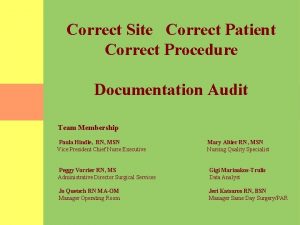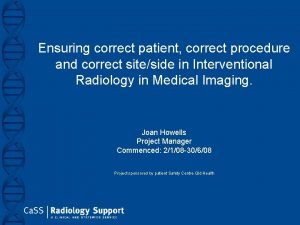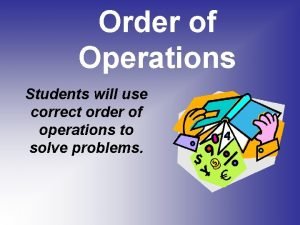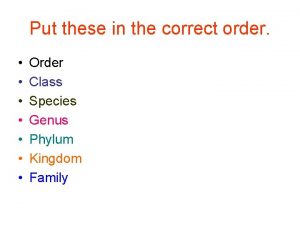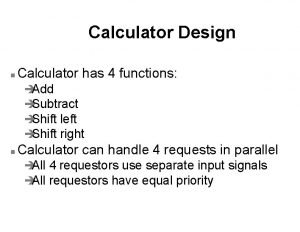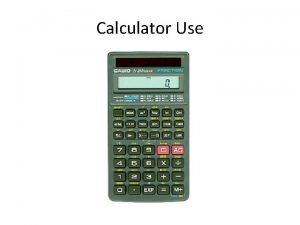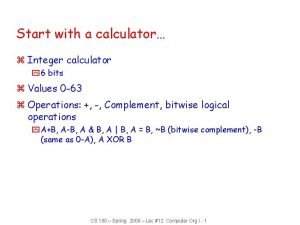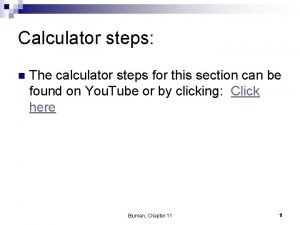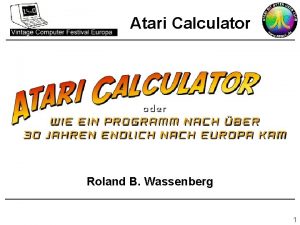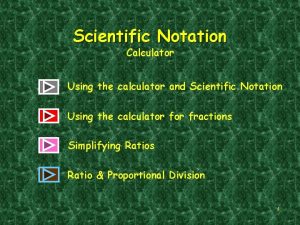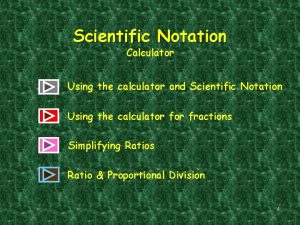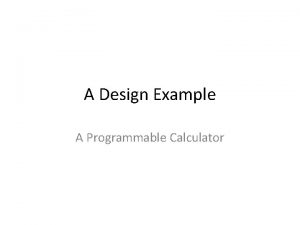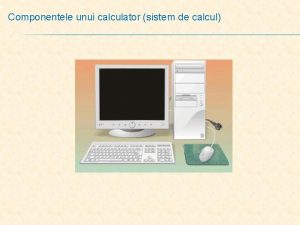IMPORTANT In order to view the correct calculator














































- Slides: 46

IMPORTANT: In order to view the correct calculator key stroke symbols within this PPT, you will need to follow the font installation directions on this document. 12 -1 Mc. Graw-Hill/Irwin Copyright © 2011 by the Mc. Graw-Hill Companies, Inc. All rights reserved.

Key Concepts and Skills • Know how to determine: – A firm’s cost of equity capital – A firm’s cost of debt – A firm’s overall cost of capital • Understand pitfalls of overall cost of capital and how to manage them 12 -2

Chapter Outline 12. 1 The Cost of Capital: Some Preliminaries 12. 2 The Cost of Equity 12. 3 The Costs of Debt and Preferred Stock 12. 4 The Weighted Average Cost of Capital 12. 5 Divisional and Project Costs of Capital 12 -3

Cost of Capital Basics • The cost to a firm for capital funding = the return to the providers of those funds – The return earned on assets depends on the risk of those assets – A firm’s cost of capital indicates how the market views the risk of the firm’s assets – A firm must earn at least the required return to compensate investors for the financing they have provided – The required return is the same as the appropriate discount rate 12 -4

Cost of Equity • The cost of equity is the return required by equity investors given the risk of the cash flows from the firm • Two major methods for determining the cost of equity - Dividend growth model - SML or CAPM Return to Quick Quiz 12 -5

The Dividend Growth Model Approach Start with the dividend growth model formula and rearrange to solve for RE 12 -6

Example: Dividend Growth Model • Your company is expected to pay a dividend of $4. 40 per share next year. (D 1) • Dividends have grown at a steady rate of 5. 1% per year and the market expects that to continue. (g) • The current stock price is $50. (P 0) • What is the cost of equity? 12 -7

Example: Estimating the Dividend Growth Rate • One method for estimating the growth rate is to use the historical average Year 2003 2004 2005 2006 2007 Dividend 1. 23 1. 30 1. 36 1. 43 1. 50 Percent Change (1. 30 – 1. 23) / 1. 23 = 5. 7% (1. 36 – 1. 30) / 1. 30 = 4. 6% (1. 43 – 1. 36) / 1. 36 = 5. 1% (1. 50 – 1. 43) / 1. 43 = 4. 9% Average = (5. 7 + 4. 6 + 5. 1 + 4. 9) / 4 = 5. 1% 12 -8

Advantages and Disadvantages of Dividend Growth Model • Advantage – easy to understand use • Disadvantages – Only applicable to companies currently paying dividends – Not applicable if dividends aren’t growing at a reasonably constant rate – Extremely sensitive to the estimated growth rate – Does not explicitly consider risk 12 -9

The SML Approach • Use the following information to compute the cost of equity – Risk-free rate, Rf – Market risk premium, E(RM) – Rf – Systematic risk of asset, 12 -10

Example: SML • • Company’s equity beta = 1. 2 Current risk-free rate = 7% Expected market risk premium = 6% What is the cost of equity capital? 12 -11

Advantages and Disadvantages of SML • Advantages – Explicitly adjusts for systematic risk – Applicable to all companies, as long as beta is available • Disadvantages – Must estimate the expected market risk premium, which does vary over time – Must estimate beta, which also varies over time – Relies on the past to predict the future, which is not always reliable 12 -12

Example: Cost of Equity • Data: – Beta = 1. 5 – Market risk premium = 9% – Current risk-free rate = 6%. – Analysts’ estimates of growth = 6% per year – Last dividend = $2. – Currently stock price =$15. 65 – Using SML: RE = 6% + 1. 5(9%) = 19. 5% – Using DGM: RE = [2(1. 06) / 15. 65] +. 06 = 19. 55% 12 -13

Cost of Debt • The cost of debt = the required return on a company’s debt • Method 1 = Compute the yield to maturity on existing debt • Method 2 = Use estimates of current rates based on the bond rating expected on new debt • The cost of debt is NOT the coupon rate 12 -14

Example: Cost of Debt Current bond issue: 30 , – 15 years to maturity 1253. 72 S. – Coupon rate = 12% 1000 0 60 / – Coupons paid semiannually %4. 45% – Currently bond price = $1, 253. 72 YTM = 4. 45%*2 = 8. 9% 12 -15

Component Cost of Debt • Use the YTM on the firm’s debt • Interest is tax deductible, so the after-tax (AT) cost of debt is: • If the corporate tax rate = 40%: Return to Quick Quiz 12 -16

Cost of Preferred Stock • Preferred pays a constant dividend every period • Dividends expected to be paid forever • Preferred stock is a perpetuity • Example: – Preferred annual dividend = $10 – Current stock price = $111. 10 RP = 10 / 111. 10 = 9% 12 -17

Weighted Average Cost of Capital • Use the individual costs of capital to compute a weighted “average” cost of capital for the firm • This “average” = the required return on the firm’s assets, based on the market’s perception of the risk of those assets • The weights are determined by how much of each type of financing is used Return to Quick Quiz 12 -18

Determining the Weights for the WACC • Weights = percentages of the firm that will be financed by each component • Always use the target weights, if possible – If not available, use market values 12 -19

Capital Structure Weights • Notation E = market value of equity = # outstanding shares times price per share D = market value of debt = # outstanding bonds times bond price V = market value of the firm = D + E • Weights E/V = percent financed with equity D/V = percent financed with debt Return to Quick Quiz 12 -20

WACC = (E/V) x RE + (P/V) x RP + (D/V) x RD x (1 - TC) Where: (E/V) = % of common equity in capital structure Weights Component costs (P/V) = % of preferred stock in capital structure (D/V) = % of debt in capital structure RE = firm’s cost of equity RP = firm’s cost of preferred stock RD = firm’s cost of debt TC = firm’s corporate tax rate 12 -21

Estimating Weights Component Values: • VE = $50 x (3 m) = $150 m Stock price = $50 3 m shares common stock • VP = $25 m • VD = $75 m $25 m preferred stock • VF = $150+$25+$75=$250 m $75 m debt Given: • • • 40% Tax rate Weights: E/V = $150/$250 P/V = $25/$250 D/V = $75/$250 = 0. 6 (60%) = 0. 1 (10%) = 0. 3 (30%) 12 -22

WACC Component Debt (before tax) Preferred Stock Common equity W 0. 30 0. 10 0. 60 R 10% 9% 14% WACC = E/V x RE + P/V x RP + D/V x RD (1 - TC) WACC = 0. 6(14%)+0. 1(9%) +0. 3(10%)(1 -. 40) WACC = 8. 4% + 0. 9% + 1. 8% = 11. 1% 12 -23

Table 12. 1 12 -24

Factors that Influence a Company’s WACC • Market conditions, especially interest rates, tax rates and the market risk premium • The firm’s capital structure and dividend policy • The firm’s investment policy – Firms with riskier projects generally have a higher WACC 12 -25

Eastman Chemical – 1 Equity Source: http: //finance. yahoo. com 12 -26

Eastman Chemical – 2 Dividend Growth Source: http: //finance. yahoo. com 12 -27

Eastman Chemical -3 Beta and Dividends Source: http: //finance. yahoo. com 12 -28

Eastman Chemical – 4 Other Data • • Market Risk Premium = 7% (assumed) T-Bill rate = 0. 07% (90 day) Tax rate (assumed) = 35% Beta (Reuters): Source: http: //www. reuters. com 12 -29

Eastman Chemical - 5 Cost of Equity - SML • Beta Yahoo. Finance Reuters Average • T-Bill rate • Market Risk Premium 2. 01 1. 92 1. 965 0. 07% 7% • Cost of Equity (SML) =. 07% + (7%)(1. 965) = 13. 83% 12 -30

Eastman Chemical - 6 Cost of Equity - DCF • Growth rate • Last dividend • Stock price 7% $1. 76 $52. 99 • Cost of Equity (DCF) = 12 -31

Eastman Chemical - 7 Cost of Equity In Textbook In Slideshow SML Method 10. 29% 13. 83% DCF Method 14. 91% 10. 55% Average 12. 60% 12. 19% 12 -32

Eastman Chemical - 8 Bonds Source: http: //cxa. marketwatch. com/finra/Bondcenter 12 -33

Eastman Chemical - 9 Bonds • Since market values are deemed more relevant, we use only market value weights • Average YTM = 6. 772% versus 8. 70% in the textbook 12 -34

Eastman Chemical - 10 WACC Capital structure weights: E = 72. 67 million x $52. 99 = $3. 851 billion D = 1. 404 billion V = $3. 851 + 1. 404 = 5. 255 billion E/V = 3. 851 / 5. 255 =. 7328 D/V = 1. 404 / 5. 255 =. 2672 WACC =. 7328(12. 19%) +. 2672(6. 772%)(1 -. 35) = 10. 11% (versus 9. 79% in text) 12 -35

Risk-Adjusted WACC • A firm’s WACC reflects the risk of an average project undertaken by the firm – “Average” risk = the firm’s current operations • Different divisions/projects may have different risks – The division’s or project’s WACC should be adjusted to reflect the appropriate risk and capital structure Return to Quick Quiz 12 -36

Using WACC for All Projects • What would happen if we use the WACC for all projects regardless of risk? • Assume the WACC = 15% 12 -37

Using WACC for All Projects • Assume the WACC = 15% • Adjusting for risk changes the decisions 12 -38

Divisional Risk & the Cost of Capital REPLACE WITH FIGURE 12. 1 Rate of Return (%) Acceptance Region WACC H Acceptance Region Rejection Region WACC F Rejection Region WACC L 0 Risk L Risk H Risk 12 -39

Divisional Risk & the Cost of Capital 12 -40

Pure Play Approach • Find one or more companies that specialize in the product or service being considered • Compute the beta for each company • Take an average • Use that beta along with the CAPM to find the appropriate return for a project of that risk • Pure play companies difficult to find Return to Quick Quiz 12 -41

Subjective Approach • Consider the project’s risk relative to the firm overall – If the project is riskier than the firm, use a discount rate greater than the WACC – If the project is less risky than the firm, use a discount rate less than the WACC Return to Quick Quiz 12 -42

Subjective Approach - Example Risk Level Very Low Risk Discount Rate WACC – 8% 7% Low Risk WACC – 3% 12% Same Risk as Firm WACC 15% High Risk Very High Risk WACC + 5% WACC + 10% 25% 12 -43

Quick Quiz • What are the two approaches for computing the cost of equity? (Slide 12. 5) • How do you compute the cost of debt and the after tax cost of debt? (Slide 12. 16) • How do you compute the capital structure weights required for the WACC? (Slide 12. 20) • What is the WACC? (Slide 12. 18) • What happens if we use the WACC as the discount rate for all projects? (Slide 12. 36) • What are two methods that can be used to compute the appropriate discount rate when WACC isn’t appropriate? (Slide 12. 41 and Slide 12. 42) 12 -44

Chapter 12 END

TI BA II+ Font Installation Close Powerpoint until the fonts are installed Print this page before closing Powerpoint Steps to installing the fonts using Windows XP or Vista: • Go to this link: http: //education. ti. com/educationportal/downloadcenter/Software. Detail. do? website=US&app. Id=61 61 • Download and [Save] the Windows designated file to your hard drive. Do not [Run] the file you are attempting to download. • Unzip the file to a location that you can easily navigate to on your computer (I’d advise using your desktop for this). Unzip by double clicking the file, choosing browse in the window that pops up, and then setting your unzip location to your desktop by selecting desktop. • You’ll have 4 files on your laptop. Two of them will have Icons ~ you’ll need to use these. • Go to “Start” “Control Panel” “Fonts. ” You can drag and drop the font file into your font folder or select “File” “Install New Font” and indicate the location of the icon files • Restart Power. Point, and open the slideshow you were attempting to view. Steps to installing the fonts on a Mac: • Go to this link: http: //education. ti. com/educationportal/downloadcenter/Software. Detail. do? website=US&app. Id=61 61 • Download the Mac designated file to your computer. • Double click the file that was downloaded. • Restart Power. Point 12 -46
 Https //forms.office.com
Https //forms.office.com Via optica
Via optica Example of a news story
Example of a news story From most important to least important in writing
From most important to least important in writing Least important to most important
Least important to most important Bmr formula mifflin st jeor
Bmr formula mifflin st jeor Objective point of view
Objective point of view Placing an order
Placing an order Phlebotomy order of draw
Phlebotomy order of draw Aqa - order of margnitude calculations.
Aqa - order of margnitude calculations. Hát kết hợp bộ gõ cơ thể
Hát kết hợp bộ gõ cơ thể Ng-html
Ng-html Bổ thể
Bổ thể Tỉ lệ cơ thể trẻ em
Tỉ lệ cơ thể trẻ em Gấu đi như thế nào
Gấu đi như thế nào Thang điểm glasgow
Thang điểm glasgow Chúa sống lại
Chúa sống lại Môn thể thao bắt đầu bằng từ chạy
Môn thể thao bắt đầu bằng từ chạy Thế nào là hệ số cao nhất
Thế nào là hệ số cao nhất Các châu lục và đại dương trên thế giới
Các châu lục và đại dương trên thế giới Công thức tính độ biến thiên đông lượng
Công thức tính độ biến thiên đông lượng Trời xanh đây là của chúng ta thể thơ
Trời xanh đây là của chúng ta thể thơ Cách giải mật thư tọa độ
Cách giải mật thư tọa độ 101012 bằng
101012 bằng độ dài liên kết
độ dài liên kết Các châu lục và đại dương trên thế giới
Các châu lục và đại dương trên thế giới Thể thơ truyền thống
Thể thơ truyền thống Quá trình desamine hóa có thể tạo ra
Quá trình desamine hóa có thể tạo ra Một số thể thơ truyền thống
Một số thể thơ truyền thống Cái miệng xinh xinh thế chỉ nói điều hay thôi
Cái miệng xinh xinh thế chỉ nói điều hay thôi Vẽ hình chiếu vuông góc của vật thể sau
Vẽ hình chiếu vuông góc của vật thể sau Thế nào là sự mỏi cơ
Thế nào là sự mỏi cơ đặc điểm cơ thể của người tối cổ
đặc điểm cơ thể của người tối cổ V. c c
V. c c Vẽ hình chiếu đứng bằng cạnh của vật thể
Vẽ hình chiếu đứng bằng cạnh của vật thể Tia chieu sa te
Tia chieu sa te Thẻ vin
Thẻ vin đại từ thay thế
đại từ thay thế điện thế nghỉ
điện thế nghỉ Tư thế ngồi viết
Tư thế ngồi viết Diễn thế sinh thái là
Diễn thế sinh thái là Dot
Dot Số nguyên là gì
Số nguyên là gì Tư thế ngồi viết
Tư thế ngồi viết Lời thề hippocrates
Lời thề hippocrates Thiếu nhi thế giới liên hoan
Thiếu nhi thế giới liên hoan ưu thế lai là gì
ưu thế lai là gì
